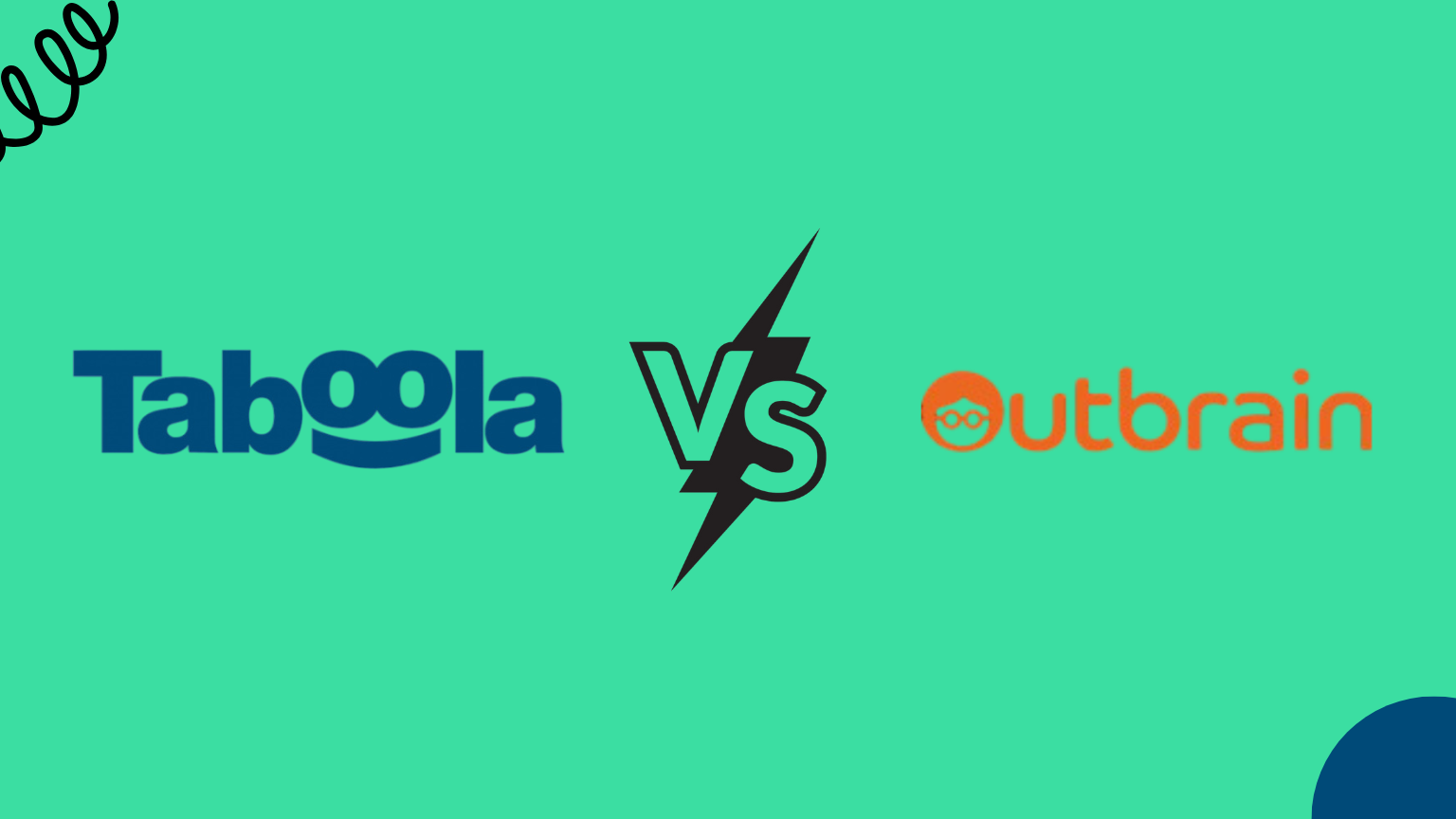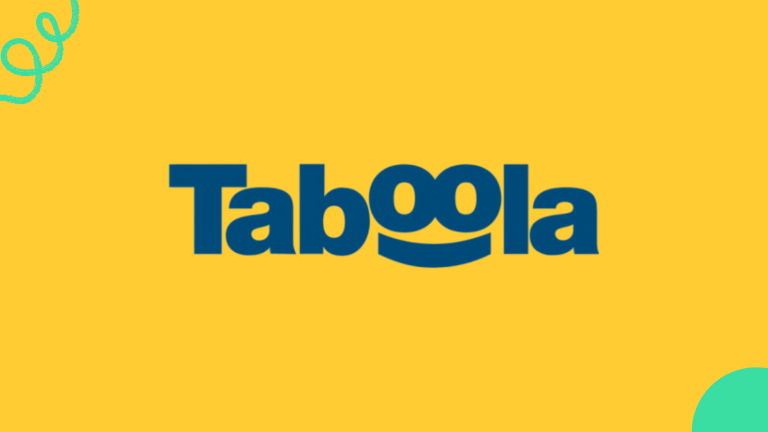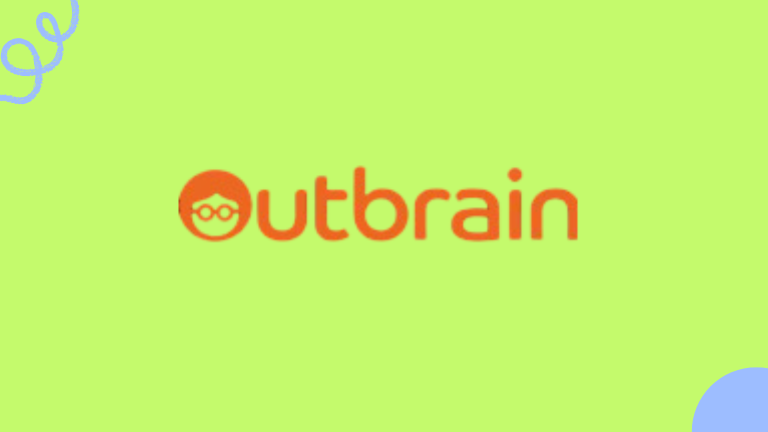Table of Contents
Taboola vs Outbrain
In today’s digital marketing landscape,Taboola and Outbrain are two of the biggest players in the world of content discovery, driving billions of clicks across the internet. Both platforms specialize in native advertising, allowing advertisers to display content recommendations to users based on their interests, search behavior, and demographics.
Taboola is often characterized by its visually engaging recommendations, focusing on a wide range of multimedia content designed to capture user interest across various websites. On the other hand, Outbrain emphasizes high-quality, editorially curated content, often aiming for interaction with a more niche audience.
In this article, we’ll explore Taboola vs. Outbrain in depth, comparing their features, performance, pricing, and overall effectiveness to help you make an informed decision on which platform to choose for your next advertising campaign.
What Is Taboola?
Taboola is a content discovery platform that helps brands get their content in front of the right audience through personalized recommendations. By analyzing user behavior, interests, and demographics, Taboola serves relevant articles, videos, and advertisements to users as they browse third-party websites.
Key Features of Taboola
- Content Discovery Platform: Recommends articles, videos, and ads based on user behavior and interests.
- Massive Publisher Network: Over 9,000 premium publishers, including major sites like NBC News and USA Today.
- Aggressive Targeting: Uses machine learning algorithms to identify user interests based on past behavior.
- CPC Pricing Model: Advertisers pay per click on their content, making it cost-effective for driving traffic.
- Variety of Ad Formats: Includes image-based ads, video ads, carousel ads, and more.
What Is Outbrain?
Outbrain, much like Taboola, provides content recommendations and native advertising solutions. It specializes in helping brands reach audiences by promoting their content across high-quality publisher networks. Outbrain uses advanced machine learning algorithms to personalize content recommendations based on users’ behavior. Outbrain’s distribution network is great as it allows users to be more organic than traditional graphics advertising on a wide range of websites. One can easily navigate the app and use it.
Key Features of Outbrain
- Content Recommendation Engine: Personalizes content delivery based on user interests and real-time behavior.
- Premium Publisher Network: Partners with high-quality publishers like CNN, ESPN, and Time.
- CPC and CPM Pricing Models: Offers both cost-per-click (CPC) and cost-per-impression (CPM) options for greater flexibility.
- Advanced Targeting Options: Provides demographic, interest-based, and behavioral targeting, along with geo-targeting down to specific cities or regions.
Native Ad Formats: Ads are designed to blend seamlessly with editorial content, enhancing user experience and engagement
Key Differences: Taboola vs Outbrain
| Feature | Taboola | Outbrain |
|---|---|---|
| Primary Focus | Content discovery and traffic generation | Content recommendations and personalized user engagement |
| Publisher Network | Over 9,000 publishers, including large networks like NBC, USA Today, and The Weather Channel | Smaller but high-quality publisher network, including CNN, ESPN, and Time |
| Targeting Options | Behavioral targeting based on past user behavior | Advanced targeting with demographic, interest-based, behavioral, and geo-targeting options |
| Ad Formats | Image-based ads, video ads, carousel ads, and more | Native ads, sponsored content, video ads, and more |
| Pricing Model | Primarily CPC (cost-per-click), with flexibility in bidding | Both CPC (cost-per-click) and CPM (cost-per-impression) |
| User Interface (UI) | Simple and intuitive dashboard, ideal for quick setups | More feature-rich and robust dashboard, better for in-depth campaign management |
| Algorithm | Focuses on aggressive targeting and maximizing clicks | Emphasizes real-time behavior analysis for highly personalized recommendations |
| Campaign Analytics | Real-time data on impressions, CTR, and engagement | Advanced A/B testing, conversion tracking, and custom reporting for optimization |
| Ad Placement Style | More aggressive with broad content recommendations | Seamless, editorial-style native ads that blend well with content |
| Content Personalization | Less refined personalization, broad content discovery | Highly refined personalization, focusing on user intent and context |
| Support and Resources | User-friendly with solid support, but less advanced learning resources | In-depth learning resources, customer support, and more advanced optimization tools |
Content Discovery vs Recommendations
Taboola Content Discovery vs. Recommendations
Taboola primarily focuses on content discovery, recommending articles, videos, and ads that are likely to appeal to users based on their previous browsing behavior. These recommendations tend to be broader and more varied, aimed at catching users’ attention in a way that feels natural but often isn’t highly personalized.
Outbrain Content Discovery vs Recommendations
Outbrain, on the other hand, excels in content recommendations, where it aims to suggest content that feels more curated for the user. Outbrain’s recommendations are typically more targeted and personalized, based on a combination of the user’s browsing history and real-time interactions.
Publisher Network
Taboola Publisher Network
Taboola has one of the largest publisher networks in the native advertising space, with over 9,000 publishers in its portfolio. This includes high-traffic sites such as NBC News, USA Today, and The Weather Channel. As a result, Taboola’s ads have the potential to reach a huge global audience. However, the vastness of this network means that traffic quality can vary, and some sites in the network may not provide the same level of engaged users as others.
Outbrain Publisher Network
Outbrain’s publisher network is smaller but more selective, consisting of premium sites like CNN, ESPN, and Time. These publishers typically have more engaged audiences, meaning the users are often higher-value and more likely to engage with the content in a meaningful way. Although the audience reach might be smaller compared to Taboola, the quality of that audience is often considered superior, especially for brands that prioritize targeted engagement over sheer volume.
Targeting Options
Taboola Targeting Options
Taboola relies heavily on behavioral targeting. This means it shows content to users based on their past browsing behavior — for example, users who have previously engaged with content related to fashion, tech, or health will see similar content. While this approach is effective for driving broad engagement, it may not always be as precise as some advertisers desire. It primarily focuses on identifying patterns in users’ past interactions with content to determine what they might like next.
Outbrain Targeting Options
Outbrain takes targeting a step further by offering a more advanced suite of targeting options. In addition to behavioral targeting, Outbrain allows advertisers to target users based on detailed demographic data (e.g., age, gender, income), interests, and real-time context (e.g., geographic location, device type). Geo-targeting is also available, enabling advertisers to focus on specific regions, cities, or even local areas. This makes Outbrain an ideal choice for campaigns requiring more precision and specific audience targeting.
Ad Formats
Taboola Ad Formats
Taboola provides a wide range of ad formats that are designed to blend in with the editorial content of a publisher’s website. These include:
Image-based ads: Simple and eye-catching ads featuring high-quality visuals to drive clicks.
Video ads: Engaging video content that appears within the content stream.
Carousel ads: These allow advertisers to showcase multiple pieces of content in a single ad unit, encouraging users to explore more options.
Taboola’s ad formats are primarily focused on attracting attention and driving traffic through visually compelling content.
Outbrain Ad Formats
Outbrain, on the other hand, is renowned for its native ad formats, which are designed to seamlessly blend into the editorial flow of the website. Outbrain’s ads look and feel like editorial content, often featuring headlines and images that are similar to the content surrounding them. Outbrain also offers video ads, and its ads often feel more contextual and less intrusive. Outbrain places a higher emphasis on content that feels native to the site, resulting in a less disruptive user experience.
Pricing Model: Taboola vs Outbrain
| Feature | Taboola | Outbrain |
|---|---|---|
| Pricing Model | Cost-Per-Click (CPC) | Cost-Per-Click (CPC) |
| Bidding Method | Auction-based CPC model | Auction-based CPC model |
| Payment Type | Pay-per-click (CPC) | Pay-per-click (CPC) |
| Minimum Spend | Varies by campaign, but typically $500 for self-serve, higher for managed accounts. | Generally starts at $1000/month for self-serve accounts. Managed accounts may have higher minimums. |
Taboola Pricing Model
Taboola typically operates on a CPC (cost-per-click) pricing model, meaning advertisers pay each time a user clicks on one of their content recommendations. Taboola’s pricing is auction-based, so the actual cost per click can vary depending on competition and the quality of the publishers on which ads are placed. The minimum spend varies by campaign, but typically $500 for self-serve, higher for managed accounts.
Outbrain Pricing Model
Outbrain offers both CPC (cost-per-click) and CPM (cost-per-impression) pricing models. The CPC model is similar to Taboola’s, where advertisers only pay when users click on their ads. However, Outbrain also provides the option for CPM, where advertisers pay for every 1,000 impressions their ads receive, regardless of whether they are clicked. The minimum spend generally starts at $1000/month for self-serve accounts. Managed accounts may have higher minimums.
User Interface (UI)
Taboola User Interface
Taboola is known for its simple and intuitive interface, which makes it easy for both beginners and experienced marketers to set up campaigns quickly. The dashboard is designed to be user-friendly, with basic performance metrics like click-through rates (CTR) and impressions readily available. For users who are looking for a streamlined experience, Taboola’s simplicity can be a big advantage.
Outbrain User Interface
Outbrain’s user interface is more feature-rich and complex, offering more granular control over campaigns. While this may come with a steeper learning curve, it’s beneficial for marketers who need advanced reporting and detailed campaign optimization tools. Outbrain’s dashboard includes features like A/B testing, conversion tracking, and custom reporting, making it ideal for more experienced users looking for in-depth insights and control over campaign performance.
Algorithm
Taboola Algorithm
Taboola’s algorithm focuses on identifying and predicting engagement patterns. It uses historical data and user behaviors to show content that is likely to get clicks, often based on what users have previously engaged with on similar topics. While this approach maximizes click volume, it can sometimes be less precise, showing users content that may not be as relevant in terms of their current interests or intent.
For instance, Entertainment companies use Taboola to drive engagement by suggesting related content to keep users watching more or to promote new, sponsored content.
Outbrain Algorithm
Outbrain’s algorithm places a heavier emphasis on real-time content recommendations. It considers users’ current browsing context, not just their past behavior. This means Outbrain is more focused on personalization and delivering recommendations based on what users are most likely interested in at the moment. Outbrain’s algorithm is designed to match content to user intent, offering a more refined and targeted experience.
Campaign Analytics
Taboola Campaign Analytics
Taboola provides real-time analytics that focus on essential performance metrics like CTR, impressions, and engagement rates. These metrics help advertisers understand how well their campaigns are performing. While these insights are useful for basic optimization, Taboola’s reporting lacks the depth offered by more advanced platforms.
Outbrain Campaign Analytics
Outbrain’s analytics are far more detailed and advanced, offering features like A/B testing, conversion tracking, and customized reporting. With these tools, advertisers can run experiments to test different headlines, images, and ad placements. Outbrain’s analytics suite also allows for real-time adjustments to campaigns based on performance metrics, helping advertisers optimize campaigns and improve ROI continuously.
Ad Placement Style
Taboola Ad Placement Style
Taboola’s ad placements are generally more aggressive in nature. It places content recommendations in a prominent, attention-grabbing way, often positioned at the bottom or sides of articles. While this helps drive clicks, it can sometimes feel like a disruption to the user experience, particularly if the content feels too commercial or out of place.
Outbrain Ad Placement Style
Outbrain’s native ads are designed to blend seamlessly into the content. The ads are often positioned in the same space as editorial content, such as at the end of articles or as part of a content stream. This results in a less intrusive experience for users and makes the content feel more like a natural extension of what they are already reading. As a result, users are more likely to engage with ads that feel more native and less like traditional advertising.
Content Personalization
Taboola Content Personalization
Taboola offers basic content personalization based on a user’s browsing history. The platform determines what content might appeal to a user based on the websites they have visited or articles they have clicked in the past. This method of personalization is effective for driving broad engagement, but it may not always result in the most relevant content being displayed.
Outbrain Content Personalization
Outbrain excels in refined personalization, using a mix of real-time behavior and user context to suggest content that aligns with current user interests and intent. This level of personalization results in more targeted content recommendations.
Conclusion
If you’re looking for massive reach, especially on a tight budget, Taboola is a great choice. Its broad network of publishers and aggressive targeting algorithms make it effective for driving high volumes of traffic.
On the other hand, if you’re aiming for more refined targeting and personalized content recommendations, Outbrain may be the better option. Outbrain excels at delivering high-quality, engaged traffic that often leads to better conversion rates.
Ultimately, your decision should depend on your campaign objectives. Consider Taboola if you want clicks and reach, or choose Outbrain if you’re aiming for precision or higher quality engagement.
FAQs
u003cstrongu003eWhat’s the difference between Taboola and Outbrain?u003c/strongu003e
u003cstrongu003eTaboola u003c/strongu003eis known for its wide reach, Taboola integrates with a large number of publishers, including mainstream sites like u003cemu003eUSA Todayu003c/emu003e and u003cemu003eThe Weather Channelu003c/emu003e. Its algorithm emphasizes engagement and clicks, often focusing on high-volume traffic sources. u003cbru003eu003cbru003eu003cstrongu003eOutbrain’s u003c/strongu003ealgorithm tends to be more premium-focused. It partners with high-end publishers like u003cemu003eCNNu003c/emu003e, u003cemu003eThe New York Timesu003c/emu003e, and u003cemu003eBBCu003c/emu003e, and its recommendation engine is tailored to focus on more quality, context-driven content.
u003cstrongu003eWhich platform has better targeting, Taboola or Outbrain?u003c/strongu003e
u003cstrongu003eTaboola u003c/strongu003eprovides diverse targeting options, includingu003cstrongu003e geographic, demographic, interest-basedu003c/strongu003e, and device targeting. It’s particularly strong in retargeting strategies, allowing advertisers to re-engage visitors who have previously interacted with their content.u003cbru003eu003cbru003eu003cstrongu003eOutbrainu003c/strongu003e offers similar targeting features, but is often favored for its u003cstrongu003eaudience-based targetingu003c/strongu003e. Outbrain leverages u003cstrongu003emachine learningu003c/strongu003e to optimize targeting and deliver highly relevant content to specific user segments.
u003cstrongu003eWhich is more cost-effective, Taboola or Outbrain?u003c/strongu003e
u003cstrongu003eTaboolau003c/strongu003e is known for being cost-effective, especially for smaller budgets. The minimum spend to get started on Taboola is typically around u003cstrongu003e$500u003c/strongu003e. This lower entry point makes it a good choice for smaller businesses or those testing out native advertising.u003cbru003eu003cbru003eWhile u003cstrongu003eOutbrain u003c/strongu003ealso offers competitive pricing, its minimum spend tends to be higher, starting aroundu003cstrongu003e $1,000/month.u003c/strongu003e
u003cbru003eu003cstrongu003eAre Taboola and Outbrain good for native advertising?u003c/strongu003e
u003cstrongu003eTaboola u003c/strongu003eis widely recognized for its ability to deliver high-volume traffic through native ads that seamlessly integrate into the content of major publishers. Its recommendation engine is geared towards maximizing clicks, making it a good choice for advertisers focused onu003cstrongu003e traffic generationu003c/strongu003e and u003cstrongu003econtent promotionu003c/strongu003e.u003cbru003eu003cbru003eSimilarly, u003cstrongu003eOutbrain u003c/strongu003eis an industry leader in native advertising, particularly in premium, contextually relevant placements. It’s often preferred by marketers aiming for quality engagement from audiences that are already highly invested in theiru003cstrongu003e content consumptionu003c/strongu003e.u003cbru003e
u003cstrongu003eWhich platform offers better content discovery: Taboola or Outbrain?u003c/strongu003e
u003cstrongu003eTaboola is u003c/strongu003eknown for its broad reach, Taboola places content on a wide range of websites, from mainstream news outlets to niche blogs. This means it’s a powerful tool for brands looking to get their content in front of a large, diverse audience.u003cbru003eu003cstrongu003eOutbrain u003c/strongu003eis also capable of driving large amounts of traffic, Outbrain is more focused on delivering premium content to a highly engaged audience.It’s particularly effective in environments where content is deeply contextual, and users are looking for relevant, high-quality recommendations.
u003cstrongu003eCan I use Taboola and Outbrain together?u003c/strongu003e
Yes, many marketers use both u003cstrongu003eTaboola u003c/strongu003eand u003cstrongu003eOutbrain u003c/strongu003etogether as part of a diversified content distribution strategy. Each platform has its own strengths, so combining them can help reach a wider audience and achieve a balanced approach to both broad traffic generation and premium engagement.u003cbru003eTaboola can help you scale your campaigns and reach au003cstrongu003e large audienceu003c/strongu003e, while Outbrain can help you target more u003cstrongu003eniche, premium audiencesu003c/strongu003e who are more likely to engage deeply with your content.



